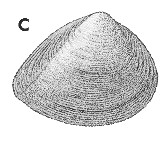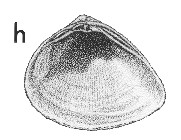
Revised descriptions of New Zealand Cenozoic Mollusca from Beu and Maxwell (1990)

 | Revised descriptions of New Zealand Cenozoic Mollusca from Beu and Maxwell (1990) | 
|
  (Pl. 19c): GS5897, J39/f6519, White Rock River, Canterbury, Altonian (GNS) |
  (Pl. 19h): GS5897, J39/f6519, White Rock River, Canterbury, Altonian (GNS) |
Beu & Maxwell (1990): Chapter 11; p. 187; pl. 19 c,h.
Synonymy: Maorimactra acuminella Finlay, 1930, p. 53; Beu & Maxwell, 1990, p. 187, pl. 19c, h.
Classification: Mactridae: Mactrinae
Description: Small for family (length 11-15 mm), subtrigonal, inequilateral, strongly inflated; postero-umbonal ridge rounded, bounding a well defined, flattened posterior area. Commarginal sculpture rather variable, of relatively prominent, narrow, rounded ridges on posterior area and near anterodorsal margin, flanks with much finer ridges and some smooth areas, particularly proximally and anterior to umbonal ridge. Left hinge with a single, prominent lamellar lateral tooth at each end, separated from dorsal margins by a long, deep groove, a small bifid median cardinal in the form of an inverted V, and a very short, curved, spur-like posterior cardinal attached to top of median cardinal. Right hinge with 2 lamellar lateral teeth at each end, the ventral one of each pair the stronger, a narrow, rather short anterior cardinal, and a much shorter posterior cardinal. External ligamental hollow very small, separated from prominent triangular resilifer by ridge. Pallial sinus moderately deep, broadly rounded.
Comparison: Mactra (Maorimactra) acuminella is very similar to the Castlecliffian-Recent type species of the subgenus, M. ordinaria, but much smaller, more inequilateral, with a more pronounced postero-umbonal ridge and a more produced, narrower posterior end. Beu (2006, p. 226, fig. 19) revised the species of M. (Maorimactra), pointing out that it does not dffer from Mactra in any characters other than small size, and illusrated the hinge of M. acuminella. It is distinctive in having the left anterior cardinal tooth aligned with the anterior lateral tooth. The Kapitean-Waipipian species M. chrydaea differs from all other species assigned to the subgenus in its greater inflation, thicker shell and more robust hinge. Mangapanian specimens are poorly known, but seem to be intermediate between M. chrydaea and M. marwicki. The Nukumaruan species M. marwicki Beu, 2006 is moderately small (alhough larger than M. acuminella) and has a still more produced posterior end than M. acuminella, and its left anterior cardinal tooth is not aligned with the anterior lateral tooth. The early Castlecliffian species M. carteri Beu, 2006 is larger than all other species assigned to the subgenus (to 34 mm long), with a thicker hinge than all species other than M. chrydaea, with a more oval, equilateral shape than all other species, and with a weaker postero-umbonal ridge than in all other species. It is a distinctive and useful index species for recognising Castlecliffian rocks in inland Wanganui Basin. Finally, the later Castlecliffian-Recent species M. ordinaria is smaller, less inflated, thinner-shelled, with a thinner hinge, and with a straighter ventral margin than M. carteri. This appears to be a simple evolutionary lineage with speciation occurring as punctuated equilibria.
Distribution: Altonian; Southburn Sand, White Rock River (type); Sutherlands, Tengawai River (moderately common).
Cite this publication as: "A.G. Beu and J.I. Raine (2009). Revised
descriptions of New Zealand Cenozoic Mollusca from Beu and Maxwell (1990). GNS
Science miscellaneous series no. 27."
© GNS Science, 2009
ISBN
978-0-478-19705-1
ISSN 1177-2441
(Included with a PDF facsimile file
copy of New Zealand Geological Survey Paleontological Bulletin 58 in CD version
from: Publications Officer, GNS Science, P.O. Box 30368 Lower Hutt, New
Zealand)